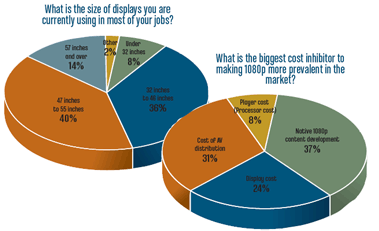New york, ny—Results of NewBay Media’s first survey addressing displays and display signal routing, conducted last month via the Systems Contractor News and Rental and Staging Systems websites, indicate several patterns and interesting market developments. Our brief survey, sponsored by Magenta Research, attempted to identify some trends in HD video for commercial AV, find out how widespread HD has become, and how HD content is getting from point A to point B. Some trends are summarized here and in the accompanying charts. Watch for more surveys to come over the course of 2010.
The biggest inhibitor to ubiquitous HD in commercial AV is not the display costs, or routing issues, but the lack of HD content. This is pretty much the opposite of CEDIA or CES market dynamics, where there is plenty of HD content (after all, the cheapest digital camera creates HD images, more highresolution than 1080p). But the cost of distribution of HD is a factor in the market—much more than the cost of 1080p displays themselves.
In many commercial AV applications, player placement is more than 300 feet away from the display. This means that UTP (twisted pair) video distribution and transmission has gained significant popularity, and in response to this acceptance of high-performance UTP video signal management solutions, manufacturers are optimizing alternative UTP designs for video applications. It also means that integration of HDCP compliant sources is becoming an increasing requirement in installations, and extension of HDCP-compliant HDMI signals up to 300 feet is now common.
Regarding market growth, digital signage ranks high among verticals where our readers see the most potential. Of course this trend dovetails with the above trends. And most of our readers see the non-ad revenue model as the most promising, indicating potential in digital signage for education, corporate lobbies and training, transportation, wait-time messaging, and wayfinding.











